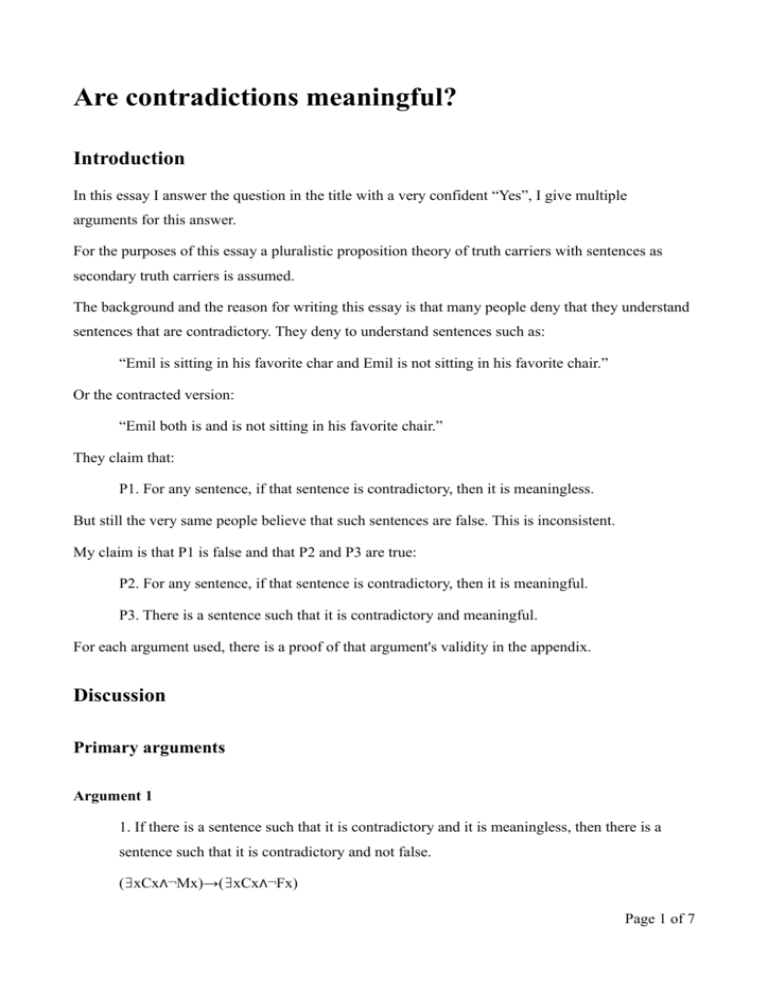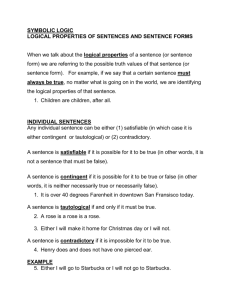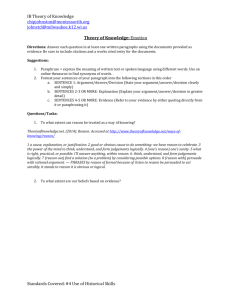Are contradictions meaningful?
advertisement

Are contradictions meaningful? Introduction In this essay I answer the question in the title with a very confident “Yes”, I give multiple arguments for this answer. For the purposes of this essay a pluralistic proposition theory of truth carriers with sentences as secondary truth carriers is assumed. The background and the reason for writing this essay is that many people deny that they understand sentences that are contradictory. They deny to understand sentences such as: “Emil is sitting in his favorite char and Emil is not sitting in his favorite chair.” Or the contracted version: “Emil both is and is not sitting in his favorite chair.” They claim that: P1. For any sentence, if that sentence is contradictory, then it is meaningless. But still the very same people believe that such sentences are false. This is inconsistent. My claim is that P1 is false and that P2 and P3 are true: P2. For any sentence, if that sentence is contradictory, then it is meaningful. P3. There is a sentence such that it is contradictory and meaningful. For each argument used, there is a proof of that argument's validity in the appendix. Discussion Primary arguments Argument 1 1. If there is a sentence such that it is contradictory and it is meaningless, then there is a sentence such that it is contradictory and not false. (∃xCx∧¬Mx)→(∃xCx∧¬Fx) Page 1 of 7 2. For any sentence, if that sentence is contradictory, then it is false. ∀xCx→Fx Thus 3. For any sentence, if that sentence is contradictory, then it is meaningful. ⊢ ∀xCx→Mx Argument 2 1. If there is a sentence such that it is contradictory and meaningless, then there is a sentence such that it is tautological and meaningless. (∃xCx∧¬Mx)→(∃xTx∧¬Mx) 2. For any sentence, if that sentence is tautological, then that sentence is meaningful. ∀xTx→Mx Thus, 3. For any sentence, if it is contradictory, then it is meaningful. ⊢ ∀xCx→Mx Argument 3 1. There is a procedure such that for any sentence, if that sentence is tautological and meaningful, and one has used the procedure on that sentence, then there is a sentence such that it is contradictory and meaningful. (∃y∀x(Tx∧Mx)∧Uyx)→∃xCx∧Mx 2. There is a procedure such that for any sentence, that sentence is tautological and meaningful, and one has used the procedure on that sentence. (∃y∀x(Tx∧Mx)∧Uyx) Thus, 3. There is a sentence such that it is contradictory and meaningful. ⊢ ∃xCx∧Mx Other inconsistent things Suppose the person who believes in P1 encounters this sentence: “There is a barber who shaves everybody who does not shave himself.” Now, if the person is not aware that that sentence is in fact a contradiction, he will probably believe Page 2 of 7 that he understands it. But if we then tell him that it is a contradiction (made from Russell's Paradox), then he will suddenly have to claim, for consistency, that he does not understand it after all. This is very odd. Consider another example involving multiple sentences: “April is taller than Betty.” “Betty is taller than Carol.” “Carol is taller than Dawn.” “Dawn is taller than Edith.” “Edith is taller than Frances.” “Frances is taller than April.” (Swartz and Bradley (1979), transcribed edition, p. 58) Now, each of these sentences are contingent and meaningful in themselves. Suppose we show these sentences one at a time to a person who believes in P1. He will probably respond that he understands them. However, suppose we tell how that they cannot all be true at the same time. Will he then respond that perhaps he didn't understand them after all? Or did he understand them all individually, but not taken together? It is all very curious. A further example involving many sentences is this: "NAT BARTLETT is very tall, gaunt, and loose-framed. His right arm has been amputated at the shoulder, and the sleeve on that side of the heavy mackinaw he wears hangs flabbily or flaps against his body as he moves. ... He closes the door and tiptoes carefully to the companionway. He ascends it a few steps and remains for a moment listening for some sound from above. Then he goes over to the table, turning the lantern very low, and sits down, resting his elbows, his chin on his hands, staring somberly before him." (Eugene O'Neill, Where the Cross is Made, copyright 1919 by Boni and Liveright. Reprinted in Twelve One-Act Plays for Study and Production, ed. S. Marion Tucker, Boston, Ginn and Co., 1929, pp. 202, 208.) (Swartz and Bradley (1979), transcribed edition, p. 15) Again, suppose we take a person that believes in P1 and makes him read the book in its entirety. Perhaps he fails to notice the contradiction and will go on to claim that he does understand the book. However, suppose we then point out the contradiction. He will then have to claim (for consistency) that he did not in fact understand all of it. That's very odd. This example is just to illustrate that the examples need not be artificial. Page 3 of 7 Perhaps the causal root of the belief in P1 is this: The believers of P1 believe in P4: P4. For any sentence and for any person, if that person understands the sentence, then that person realizes all of that sentence's implications. In the case of contradictory sentences, among their implications is that they imply the negation of themselves (indeed, they imply everything). So, when we show a believer in P1 a sentence like the Barber Paradox, he thinks that he understands it. But when we then tell him that it is contradictory and thus implies everything, he then concludes that he didn't understand it after all. This follows from P4 and that he did not realize all of the implications of the sentence. P4 has some intuitive support but upon scrutiny it is clearly false. For instance, for many years, people had been using what is now called naive set theory, but it turned out that it was contradictory. But from that and P4 it follows people did not understand naive set theory after all. That's clearly false. It gets worse. Consider the fact that any sentence has an infinite number of implications, and that no one realizes all of the implications that any given sentence has. It follows that no one understands any sentence. Another clearly false result. Supportive arguments Argument 3a The procedure mentioned in argument 2 is this: 1. Take a sentence that is meaningful and tautological. 2. Add “not” or “It is not the case that, “ to that sentence in the grammatically correct place. 3. The result is a sentence that is meaningful and contradictory. Here is an example where one can use both methods of negation (the simple and the complex). Example sentence 1: “2 plus 2 is identical with 4” Results: “2 plus 2 is not identical with 4” “It is not the case that 2 plus 2 is identical with 4” Here is an example where one can only use the one second method of negation (the complex). Page 4 of 7 Example sentence 2: “Either it rains or it does not.” Result: “It is not the case that, it either rains or it does not.” Also, see my essay Negating sentences in english. It would be an odd position to hold that if one used the procedure above on tautological, meaningful sentences, then one gets contradictory and meaningless sentences, but if one used the procedure on contingent, meaningful sentences, then one gets contingent, meaningful sentences. Why would the one result in meaningless sentences and not the other? That's very strange. Appendix Proofs of validity Argument 1 (∃xCx∧¬Mx)→(∃xCx∧¬Fx) ∀xCx→Fx ⊢ ∀xCx→Mx Page 5 of 7 Argument 2 (∃xCx∧¬Mx)→(∃xTx∧¬Mx) ∀xTx→Mx ⊢ ∀xCx→Mx Page 6 of 7 Argument 3 (∃y∀x(Tx∧Mx)∧Uyx)→∃xCx∧Mx ∃y∀x(Tx∧Mx)∧Uyx ⊢, ∃xCx∧Mx Form is just for clarity, it also has the form of modus ponens. Page 7 of 7









